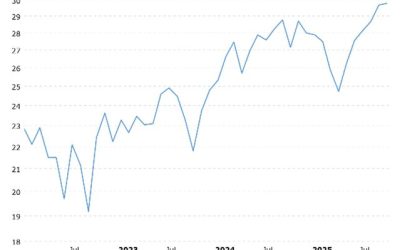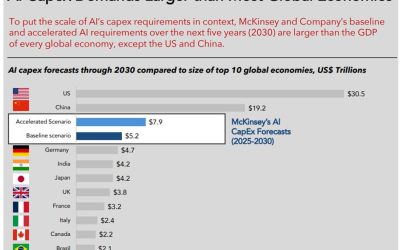by Louis Navellier
October 14, 2025
We tend to focus on our own government’s dysfunctions, but despite the federal government shutdown, the U.S. remains an oasis for most of the world, with better demographics than Asia and Northern Europe, higher key interest rates and stronger GDP growth. Our GDP is surging, partly due to the onshoring that the Trump Administration is pushing, especially in the automotive, pharmaceutical and semiconductor industries. Even some of the weaker economic indicators are “good news,” since any bad news is often considered to be “good news,” because weak economic news tends to prompt more key interest rate cuts.
The recent global turmoil goes far beyond wars. For example, Japan now has its fifth prime minister in the past five years, Sanae Takaiche. In one of her first moves, she caused the Nikkei Tokyo index to surge based on her promise of fiscal stimulus, but unfortunately, this “Takaiche trade” put the Bank of Japan in a pickle, since they will not be able to raise interest rates, so the Japanese yen gapped down almost 2%.
Another example of global turmoil is that France has lost its new prime minister after just three weeks in office. Specifically, Sebastien Lecornu became the shortest-serving French prime minister since 1958 and the third prime minister since 2024, due mostly to the inability of French leaders to finalize a budget with Parliament, which is controlled by Marine Le Pen’s National Rally Party, so France is at an impasse.
French President Emmauel Macron continues to cling to power by refusing to call an election,
so, he just re-appointed the 39-year-old Lecornu instead.
. As a result, the French political crisis continues to escalate. When he finally calls for an election, Marine Le Pen cannot run due to an EU ban on her being president for five years, so her lieutenant, Jordan Bardella, 29, could become the next President of France.
Another leadership crisis in the European Union has surfaced in the Czech Republic, where the elected billionaire Andrej Babis’s ANO Party will create a conservative ruling collation. Babis is vowing to make the Czech Republic “the best place to live” in the EU, since the Czech Republic is now more resilient against EU mandates, especially immigration. Babis has also been a critic of providing unlimited aid to Ukraine, making the Czech Republic more like Hungary and Poland by pushing back on EU mandates.
Back home, our federal government shutdown is mostly due to the huge budget battles between the two major Party leaders in Congress. Also, the minutes of the last Federal Open Market Committee (FOMC) meeting were released last Wednesday, saying, “A few participants stated there was merit in keeping the federal funds rate unchanged at this meeting, or that they could have supported such a decision.”
In a great example of Fed double-speak, the FOMC minutes also said, “It likely would be appropriate to ease policy further over the remainder of this year.” But since the last FOMC meeting, a lot has happened – negative ADP private payroll reports for three of the past four months, declining Treasury yields and a government shutdown – so the futures market now expects two-more Fed rate cuts this year.
Could a Potential “Black Swan” Event Subvert This Market?
October is often a choppy market month, but we usually see year-end rallies beginning in late October, as the holiday season begins. In my Barron’s editorial last week, I mentioned that “barring a black swan event” the stock market would stage an impressive year-end rally. What could that black swan event be?
If we have another “black swan event,” I think it would most likely be caused by an implosion of the $3- trillion per year Private Credit industry that is paying investors 11% yields via leveraged loans in lower grade credit. In addition, Bloomberg has reported that some big Wall Street firms, led by Citigroup and Goldman Sachs, are apparently on the hook for $2.6-billion in leveraged bets in short-term Treasuries.
S&P Global Market Intelligence recently issued a special report that flagged an “alarming surge” in selective defaults. Leveraged loan defaults continue to rise in the wake of the First Brands (auto parts) bankruptcy as well as the Tricolor Holdings (subprime auto loans) liquidation, which in turn continues to hinder the private credit industry. For example, Jefferies reported that one of its credit funds, Point Bonita Capital, has about $715 million of exposure linked to “receivables” from First Brands’ customers.
Overall, Point Bonita Capital has a total of about $3-billion in “trade financed assets.” Another First Brands’ creditor, Rainstone, claimed that as much as $2.3-billion has “simply vanished.” Rainstone operates a fund for UBS and claims that it is owed at least $172-million by First Brands.
The DOJ opened an investigation into First Brands on Thursday, so more news on creditor losses may emerge in the upcoming weeks. If the leveraged loan default rate rises above 9%, I suspect that the private credit industry will grind to a halt. Another possibility is that the Fed comes to the rescue with rate cuts just in time to save the private credit industry by allowing distressed lenders to refinance at lower yields.
Amidst this opaque and obscure world of leveraged finance, the U.S. stock market is standing out as a more certain investment due to double-digit earnings growth, the strongest earnings surprises in the past four decades (in the second quarter), positive seasonality and strong fund inflows, especially from foreign investors. The technology stock giants are playing a game of “betting on your favorite billionaire.” Whether you pick Tim Cook, Jensen Huang, Mark Zuckerberg, or others, is up to you. I have placed my biggest bet on Nvidia CEO Jensen Huang, but a new billionaire influencing the stock market is OpenAI’s Sam Altman, which recently announced a “strategic partnership” with AMD that sent its stock soaring.
Nvidia (NVDA) reached an all-time high last Friday morning before correcting in the afternoon, along with the rest of the market. For years now, I have been very clear that I think Nvidia is the AI leader, but Sam Altman seems concerned about the availability of Nvidia GPUs, so it appears that OpenAI also had to make a deal with AMD. Nvidia GPUs are superior to the competition, but AI growth is lifting all boats.
Nvidia has been featured in favorable articles in Bloomberg, Investor’s Business Daily, The Motley Fool, YahooFinance and Zacks. In my opinion, the company will trade at over $200 per share fairly soon (after hitting $195 last Friday). Nvidia’s founder, Jensen Huang, said the “Demand for Blackwell is insane.”
The Latest Trends in the U.S. Economy and Stock Market
Despite these leveraged debt risks, The Wall Street Journal wrote last week that Treasury Secretary Scott Bessent told President Trump that he believes the employment numbers will start to tick-up once tax policies from his “big beautiful” bill are fully implemented. Trump’s economic advisors also apparently assured him that the economic indicators will show improvements in the upcoming months. Naturally, the fact that the U.S. economy has lower private payrolls for three of the past four months is taking a toll.
As for the latest shutdown, a memo from the Office of Management and Budget said that the Trump administration isn’t obligated to pay the furloughed employees. When President Trump, on Tuesday, was asked about furloughed federal employees, he said, “I would say it depends on who we’re talking about,” adding that there are some people who “really don’t deserve to be taken care of, and we’ll take care of them in a different way.” Trump also said that the Democrats “have put a lot of people in great risk and jeopardy.” Also, White House budget director Russell Vought said last week that layoffs would begin in the days after the federal government shutdown. Trump added, on Tuesday, that Vought has prepared a list of government programs that he wants to “permanently eliminate,” and the list will be announced soon.
I have noticed that as economic anxieties rise, talk of a stock market “bubble” has increased again. Paul Tudor Jones said on CNBC that the stock market is reminiscent of the setup leading up to the burst of the dot-com bubble in late 1999. However, Jones also said that this bull market still has room to run before it reaches its final phase. With this warning in mind, I’d say it is imperative that the stock market’s breadth and power must improve, setting us apart from any 1999 dangers. Furthermore, it would be odd for the stock market to fizzle while the Fed is cutting interest rates, so I do not think we need fear a stock market bubble bursting, since as long as the analyst community is raising earnings estimates and the Fed is cutting key interest rates, we can invest confidently in the A-rated stocks in our Stock Grader.
And finally, if you don’t have enough to worry about, President Trump announced last week that he would impose an additional 100% tariff on China as well as export controls on “any and all critical software” on November 1st after threatening to cancel an upcoming meeting with China’s President, Xi Jinping!
On Truth Social, President Trump said, “China has taken an extraordinarily aggressive position on Trade in sending an extremely hostile letter to the world, stating that they were going to, effective November 1st, 2025, impose large scale Export Controls on virtually every product they make, and some not even made by them.” Trump’s tariffs would raise import taxes on many Chinese goods to 130% on November 1st. Clearly, President Trump wants to raise the stakes so he can negotiate a better trade deal with China.
Navellier & Associates; own Nvidia Corp (NVDA), and Advanced Micro Devices, Inc. (AMD), in managed accounts. Navellier does not own Jefferies Group (JEF), Citi Group ( C), UBS Group (UBS) or Goldman Sacks (GS). Louis Navellier and his family own Nvidia Corp (NVDA), via a Navellier managed account and in a personal account. They do not personally own Advanced Micro Devices, Inc. (AMD), Jefferies Group (JEF), Citi Group (C), UBS Group (UBS) or Goldman Sacks (GS).
The post 10-14-25: Global Turmoil is Rising Among Other Major Governments appeared first on Navellier.







